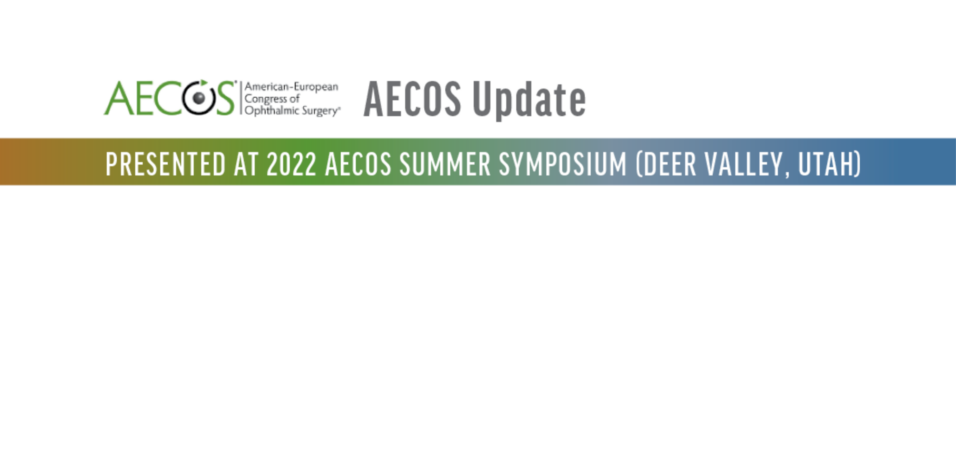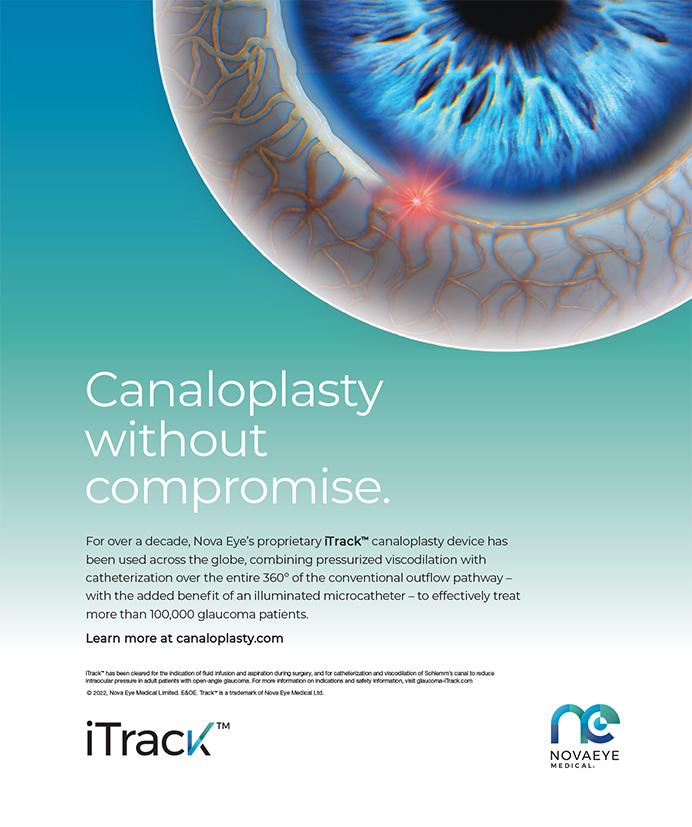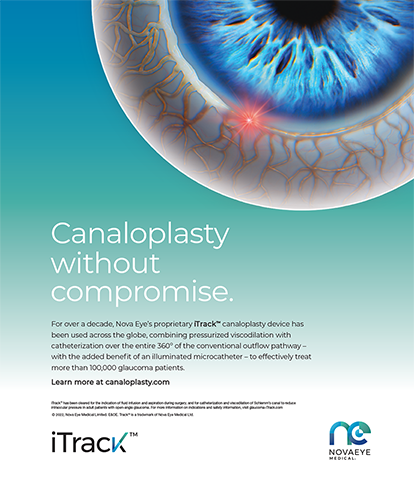
Over the past decade, retina surgeons have gained access to myriad new drugs and novel treatments and benefited from advances in diagnostic and imaging technologies. Intravitreal antivascular endothelial growth factor (anti-VEGF) injections have probably had the greatest impact on patient care recently, but challenges remain.
THE TREATMENT BURDEN
For patients with age-related macular degeneration (AMD) and diabetic macular edema (DME), the treatment burden associated with anti-VEGF therapy can be overwhelming. They must be reinjected frequently and chronically—typically every 4 to 6 weeks—and monitored with serial imaging to detect changes to the retinal structures. Studies have shown that more anti-VEGF injections lead to better outcomes. Compliance with such a demanding appointment schedule, however, is variable.
There is also a burden on the practice to find appointments for these patients. Patients participating in clinical trials, on average, receive more injections than patients who are treated in the so-called real world. Often, real-world patients are asked by the clinician to come back for their next injection in 4 weeks and told by the scheduler that the first available appointment is in 7 weeks. These patients therefore tend not to achieve the same results as patients had in clinical trials.
GREATER DURABILITY
The treatment burden has pushed the pharmaceutical industry to develop agents with greater durability. The following FDA-approved injection treatments are listed in the order of launch timing.
Lucentis (ranibizumab, Genentech). Approved in 2006, ranibizumab is typically injected every 28 days (once a month).1
Eylea (aflibercept, Regeneron). Approved in 2011, aflibercept is typically injected every 4 weeks for the first 3 months followed by every 8 weeks thereafter. Some patients may respond well to one dose every 12 weeks after 1 year of effective therapy.2
Beovu (brolucizumab-dbll, Novartis). Approved in 2019, brolucizumab-dbll is typically injected once a month for the first three doses followed by once every 8 to 12 weeks for the treatment of wet AMD and every 6 weeks for the first five doses followed by once every 8 to 12 weeks for the treatment of DME.3 Brolucizumab-dbll is rarely utilized because of intraocular inflammation with vaso-occlusive disease.
Vabysmo (faricimab-svoa, Genentech). Approved simultaneously for neovascular AMD and DME in 2022, faricimab-svoa is typically injected every 4 weeks for the first four doses followed by once every 8 to 12 weeks for the treatment of neovascular AMD and either once every 4 weeks for at least four doses that is thereafter modified by extensions of up to 4 week intervals or reductions of up to 8 week intervals based on evaluations or once every 4 weeks for the first six doses followed by once every 8 weeks.4 Clinical trials showed the treatment to be noninferior to aflibercept, with a slightly longer durability.5
Durability should not come at the expense of efficacy, which currently is a major concern in clinical trial designs. In my experience, most patients say they notice a decrease in their visual performance when injections are delayed. This, however, helps promote good patient compliance.
OTHER DURABILITY-DRIVEN PRODUCTS
Susvimo port delivery system (Genentech). The refillable, surgically implanted drug reservoir can be refilled with a special formulation of ranibizumab. Typically, the device will last 6 to 32 months before it needs to be refilled. In one study, Susvimo, refilled at week 24, was noninferior and equivalent to monthly ranibizumab injections. Most patients (98.4%) in the group that received treatment with Susvimo required no rescue therapy during the first interval of therapy (24 weeks).6 The safety analysis, however, revealed some issues. It is thought that a better surgical technique should reduce the rates of endophthalmitis (1.6%), implant dislocation (1.6%), and conjunctival retraction extrusion (12%) seen in the clinical trial. Some of the safety issues have already been addressed by the company.
KSI-301 (Kodiak Bioscience). This antibody biopolymer conjugate did not meet the primary endpoint of noninferiority to aflibercept in a phase 2b/3 clinical trial for neovascular AMD because of an overly ambitious durability endpoint.7 Trials on the safety and efficacy of KSI-301 for the treatment of DME, nonproliferative diabetic retinopathy, and retinal vein occlusion are ongoing.
AGENTS UNDER DEVELOPMENT
Geographic atrophy (GA) is approximately 10 times more common than neovascular AMD, yet currently there is no approved treatment. Research on GA is challenging. There is a high dropout rate in clinical trials, and compliance may be an issue with injections every 1 to 2 months and no hope for visual improvement. There is also a question of whether comprehensive ophthalmologists and optometrists will acquire a fundus autofluorescence device, which is the most effective monitoring tool, or refer patients with GA to retina specialists.
Two agents are in phase 3 trials for alternative complement pathway targets.
APL 2006 (Apellis). FDA approval of the bispecific C3 and VEGF inhibitor is likely. One of two phase 3 trials did not meet its primary endpoint.8
Zimura (avacincaptad pegol, Iveric Bio). This agent is designed to target and inhibit the cleavage of complement protein C5 and the formation of its downstream fragments, C5a and C5b. The company has an agreement with the FDA under the Special Protocol Assessment for its GATHER2 phase 3 clinical trial for GA secondary to AMD. No results are available.
MORE RETINAL UPDATES
Artificial intelligence. AI for retinal image screening is massively overhyped. Humans still do it better, and there is no shortage of available image readers. Even if AI for retinal imaging were more widely used, it would not address the economics and shortage of physicians to inject anti-VEGF agents for AMD or DME or perform laser treatment for DME and proliferative diabetic retinopathy.
Retinal detachment from 1.25% pilocarpine drops for presbyopia. Retinal detachment (RD) after the application of topical pilocarpine for the treatment of presbyopia has been reported in the literature.9 The mechanism of RD is thought to be a ciliary spasm–induced posterior vitreous detachment, a well-known cause of retinal breaks and RD. Although no data support this approach, patients with a history of RD, lattice degeneration, untreated retinal holes, or a family history of RD should probably not be prescribed topical pilocarpine treatment.
Sutured or scleral-fixated hydrophilic IOLs. Vitrectomy plus gas for retinal detachment repair can cause a hydrophilic IOL to become calcified.10
PRE- and POSTOPERATIVE OCT ASSESSMENT IS CRUCIAL
I have long been a staunch advocate of OCT before cataract surgery because cystoid macular edema (CME); vitreomacular traction syndrome; vitreomacular schisis; and some cases of neovascular AMD, DME, and central serous retinopathy are invisible on slit-lamp, indirect ophthalmoscopy, and digital fundus examinations. Further, I believe OCT should be done at every visit after cataract surgery.
Researchers utilized the AAO Intelligent Research in Sight (IRIS) Registry to calculate the frequency of CME diagnoses within 3 months of cataract surgery. Of the 5,875,940 cataract surgeries that were performed between 2013 and 2019, CME was diagnosed in 32,733 eyes (0.6%) of 28,401 patients. The average time to CME diagnosis was 6 weeks after cataract surgery (personal communication with Steven J. Dell, MD).
*Retina Today is a sister publication to CRST
1. Lucentis prescribing information. March 2018. Accessed January 11, 2023. www.gene.com/download/pdf/lucentis_prescribing.pdf
2. Eylea prescribing information. August 2022. Accessed January 11, 2023. www.regeneron.com/downloads/eylea_fpi.pdf
3. Beovu prescribing information. December 2022. Accessed January 11, 2023. www.novartis.com/us-en/sites/novartis_us/files/beovu.pdf
4. Vabysmo prescribing information. January 2022. Accessed January 11, 2023. www.gene.com/download/pdf/vabysmo_prescribing.pdf
5. Khanani AM, Patel SS, Ferrone PJ, et al. Efficacy of every four monthly and quarterly dosing of faricimab vs ranibizumab in neovascular age-related macular degeneration: the STAIRWAY phase 2 randomized clinical trial. JAMA Ophthalmol. 2020;138(9):964-972.
6. Holekamp NM, Campochiaro PA, Chang MA, et al. Archway randomized phase 3 trial of the port delivery system with ranibizumab for neovascular age-related macular degeneration. Ophthalmology. 2022;129(3):295-307.
7. Kodiak Sciences announces top-line results from its initial phase 2b/3 study of KSI-301 in patients with neovascular (wet) age-related macular degeneration. Kodiak. February 23, 2022. Accessed January 11, 2023. https://ir.kodiak.com/news-releases/news-release-details/kodiak-sciences-announces-top-line-results-its-initial-phase-2b3
8. Nittala MG, Metlapally R, Ip M, et al. Association of pegcetacoplan with progression of incomplete retinal pigment epithelium and outer retinal atrophy in age-related macular degeneration: a post hoc analysis of the FILLY randomized clinical trial. JAMA Ophthalmol. 2022;140(3):243-249.
9. Al-Khersan H, Flynn Jr HW, Townsend JH. Retinal detachments associated with topical pilocarpine use for presbyopia: pilocarpine-associated retinal detachments. Am J Ophthalmol. 2022;242:52-55.
10. Marcovich AL, Tandogan T, Bareket M, et al. Opacification of hydrophilic intraocular lenses associated with vitrectomy and injection of intraocular gas. BMJ Open Ophthalmology. 2018;318-000157.




